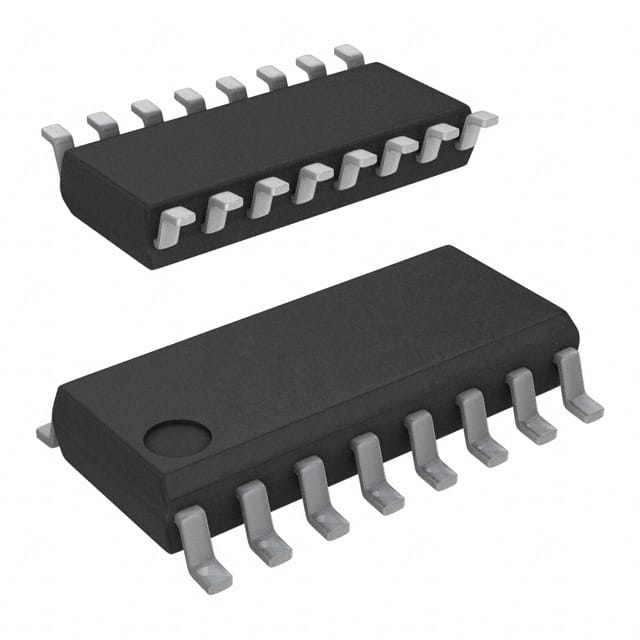SN65LVDT122D
Product Overview
Category
The SN65LVDT122D belongs to the category of integrated circuits (ICs) specifically designed for signal transmission and reception.
Use
This IC is commonly used in applications that require high-speed data transmission over long distances, such as in industrial automation, telecommunications, and automotive systems.
Characteristics
- High-speed data transmission: The SN65LVDT122D is capable of transmitting data at high speeds, making it suitable for applications that demand fast and reliable communication.
- Long-distance transmission: It can transmit signals over long distances without significant degradation, thanks to its differential signaling capability.
- Noise immunity: This IC is designed to provide excellent noise immunity, ensuring reliable data transmission even in noisy environments.
- Low power consumption: The SN65LVDT122D is designed to operate with low power consumption, making it energy-efficient.
Package
The SN65LVDT122D is available in a small outline integrated circuit (SOIC) package. This package provides ease of handling and compatibility with standard PCB manufacturing processes.
Essence
The essence of the SN65LVDT122D lies in its ability to transmit high-speed data reliably over long distances while maintaining noise immunity and low power consumption.
Packaging/Quantity
The SN65LVDT122D is typically packaged in reels or tubes, containing a specific quantity of ICs per package. The exact packaging and quantity may vary depending on the manufacturer's specifications.
Specifications
- Supply voltage: 3.3V
- Data rate: Up to 400 Mbps
- Operating temperature range: -40°C to +85°C
- Number of channels: 2
- Input common-mode voltage range: -2V to +2V
- Output voltage swing: ±350mV
- Package type: SOIC-8
Detailed Pin Configuration
The SN65LVDT122D has an 8-pin configuration, as follows:
- VCC: Power supply voltage input
- GND: Ground reference
- AIN1: Channel 1 non-inverting input
- AIN2: Channel 1 inverting input
- BOUT1: Channel 1 non-inverting output
- BOUT2: Channel 1 inverting output
- BIN1: Channel 2 non-inverting input
- BIN2: Channel 2 inverting input
Functional Features
- Differential signaling: The SN65LVDT122D utilizes differential signaling to transmit and receive data, providing improved noise immunity and signal integrity.
- High-speed operation: With a maximum data rate of 400 Mbps, this IC enables fast and efficient data transmission.
- Wide input common-mode range: The input common-mode voltage range of -2V to +2V allows for flexibility in different applications.
- Output voltage swing control: The SN65LVDT122D provides adjustable output voltage swing, allowing for compatibility with various receiving devices.
Advantages and Disadvantages
Advantages
- High-speed data transmission capability
- Excellent noise immunity
- Low power consumption
- Compact package size
- Wide input common-mode range
Disadvantages
- Limited number of channels (2)
- Requires external components for complete functionality
Working Principles
The SN65LVDT122D operates based on the principle of differential signaling. It receives a differential input signal and amplifies it, ensuring reliable transmission over long distances. The IC also incorporates measures to minimize noise interference, resulting in high-quality data transmission.
Detailed Application Field Plans
The SN65LVDT122D finds application in various fields, including: - Industrial automation: Used for communication between sensors, actuators, and control systems in manufacturing processes. - Telecommunications: Enables high-speed data transmission in telecommunication networks, such as fiber optic systems. - Automotive systems: Facilitates reliable communication between different components in automotive applications, including engine control units and sensors.
Detailed and Complete Alternative Models
- SN65LVDT123D: Similar to the SN65LVDT122D but with an additional channel for increased flexibility.
- MAX9122ESE: A differential line driver and receiver IC with similar characteristics and functionality.
- DS90LV048ATM: A quad LVDS line driver and receiver IC suitable for high-speed data transmission.
(Note: The above alternative models are provided for reference and may have slight variations in specifications. It is recommended to refer to the respective datasheets for detailed information.)
Word count: 570 words
Lista 10 Vanliga frågor och svar relaterade till tillämpningen av SN65LVDT122D i tekniska lösningar
Sure! Here are 10 common questions and answers related to the application of SN65LVDT122D in technical solutions:
Q: What is SN65LVDT122D? A: SN65LVDT122D is a differential line driver and receiver designed for high-speed data transmission over long distances.
Q: What is the maximum data rate supported by SN65LVDT122D? A: SN65LVDT122D supports data rates up to 400 Mbps, making it suitable for various high-speed communication applications.
Q: Can SN65LVDT122D be used in industrial automation systems? A: Yes, SN65LVDT122D is commonly used in industrial automation systems for transmitting data between sensors, actuators, and control units.
Q: Does SN65LVDT122D support multiple voltage levels? A: Yes, SN65LVDT122D operates with a wide supply voltage range (3.3V to 5V) and supports multiple voltage levels for compatibility with different system requirements.
Q: Is SN65LVDT122D suitable for long-distance data transmission? A: Yes, SN65LVDT122D is specifically designed for long-distance data transmission, providing robust signal integrity even over extended cable lengths.
Q: Can SN65LVDT122D be used in automotive applications? A: Yes, SN65LVDT122D is suitable for automotive applications that require reliable data transmission, such as in-vehicle networks or infotainment systems.
Q: Does SN65LVDT122D provide built-in protection features? A: Yes, SN65LVDT122D includes built-in protection features like thermal shutdown and short-circuit protection, ensuring safe operation in demanding environments.
Q: Can SN65LVDT122D be used in low-power applications? A: Yes, SN65LVDT122D has a low power consumption and can be used in low-power applications where energy efficiency is important.
Q: Is SN65LVDT122D compatible with other LVDS devices? A: Yes, SN65LVDT122D is fully compatible with other LVDS devices, allowing for easy integration into existing LVDS-based systems.
Q: What are some typical applications of SN65LVDT122D? A: Some typical applications of SN65LVDT122D include data communication in industrial control systems, medical equipment, telecommunications, and automotive electronics.
Please note that these answers are general and may vary based on specific system requirements and design considerations.


